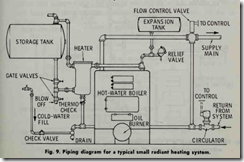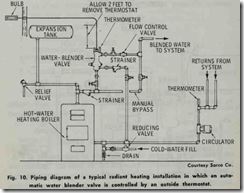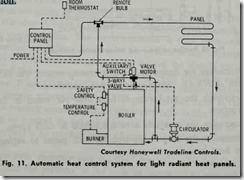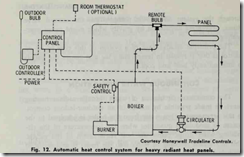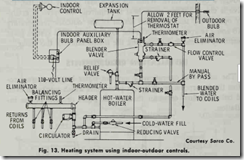SYSTEM COMPONENTS
A hot-water radiant panel heating system generally consists of the following basic components:
1.Hot-water boiler,
2. Circulating pump,
3. Expansion tank,
4. Automatic controls,
5. Valves and piping,
6. Air vents.
These system components are described in the sections that follow. Figs. 9 and 10 illustrate some typical arrangements of these components.
BOILER AND CIRCULATING PUMP
The boilers used in hot water panel heating are generally the conventional gas fired or oil fired units found in other types of hot water heating systems. These are compact boilers designed for installation in closets or in similar locations where space is limited.
The size of the circulating pump selected for a radiant panel heating system will depend upon the pressure drop in the system and the rate at which water must circulate. The circulation rate of the water is determined by the heating load and the design temperature drop of the system, and is expressed in gallons per minute (gpm).
This can be calculated by using the following formula:
The total heating load is calculated for the structure and is expressed in Btu’s per hour. A value of 20 °F. is generally used for the design temperature drop (T) in most hot water radiant panel heating systems. The other two values in the formula are the minutes per hour (60) and the weight (in pounds) of a gallon of water (8)
By way of example, the rate of water circulation for a structure with a total heating load of 30,000 Btu/hr may be calculated as follows:
AUTOMATIC CONTROLS
While any thermostatic method of control will function with a radiant panel heating system, the most desirable method is that based on continuous circulating hot water. The temperature of the water should be automatically adjusted to meet outdoor conditions, but the circulation itself controlled by interior limiting type thermostats rather than the simple off on method of circulating hot water at a fixed temperature. Standard equipment of both types is readily available (Figs. 11, 12 and 13).
NONCONTINUOUS WATER CIRCULATION
The flow of water in some radiant heating systems is controlled by the pump. When the room thermostat calls for heat, the booster pump starts and rapidly circulates heated water through the radiant panels until the heat requirement is satisfied. The pump is then shut off by the thermostat. In some systems, a flow control valve is forced open by the flow of water through the pipes as long as the pump is running, permitting free circulation of heated water through the system. When the pump stops, the control valve closes, preventing circulation by gravity which might cause overheating.
The principal disadvantage of a system of this type of off on control is that it results in temperature lag and causes the panels to intermittently heat and cool.
CONTINUOUS WATER CIRCULATION
The continuous circulation of water through radiant heating panels is made possible by means of an outdoor indoor control. In this arrangement, hot water from the boiler is admitted to the system in modulated quantities when the temperature of the circulating water drops below the heat requirement of the panels. This modulated bleeding of water into the panel is accomplished through a bypass valve. When no additional heat is required, the valve is closed. When more heat is required, the valve is gradually opened by the combined action of the outdoor temperature bulb and a temperature bulb in the supply main. This system gives control by the method of varying the temperature of the water.
INSTALLATION REQUIREMENTS
The successful operation of any hot water heating system requires the incorporation of design provisions which assure an even and balanced flow of water through the pipes or coils of the installation.
The procedure for designing a panel heating system was outUned by the ASHRAE 1960 Guide, p. 436. as follows:
1. Determine the total rate of heat loss per room in the structure.
2. Determine the available area for panels in each room.
3. Determine the output required by each panel to replace the heat loss.
4. Determine the required surface temperature for each panel.
5. Determine the required heat input to the panel (should equal heat output).
6. Determine the most efficient and economical means of supplying heat to the panel.
7. Install adequate insulation on the reverse side and edges of the panel to prevent undesirable heat loss.
8. Install the panels opposite room areas where the greater heat loss occurs.
Never use ceiling panels in rooms or spaces with low ceilings. Always keep floor temperatures at or below recommended limits.

